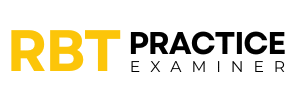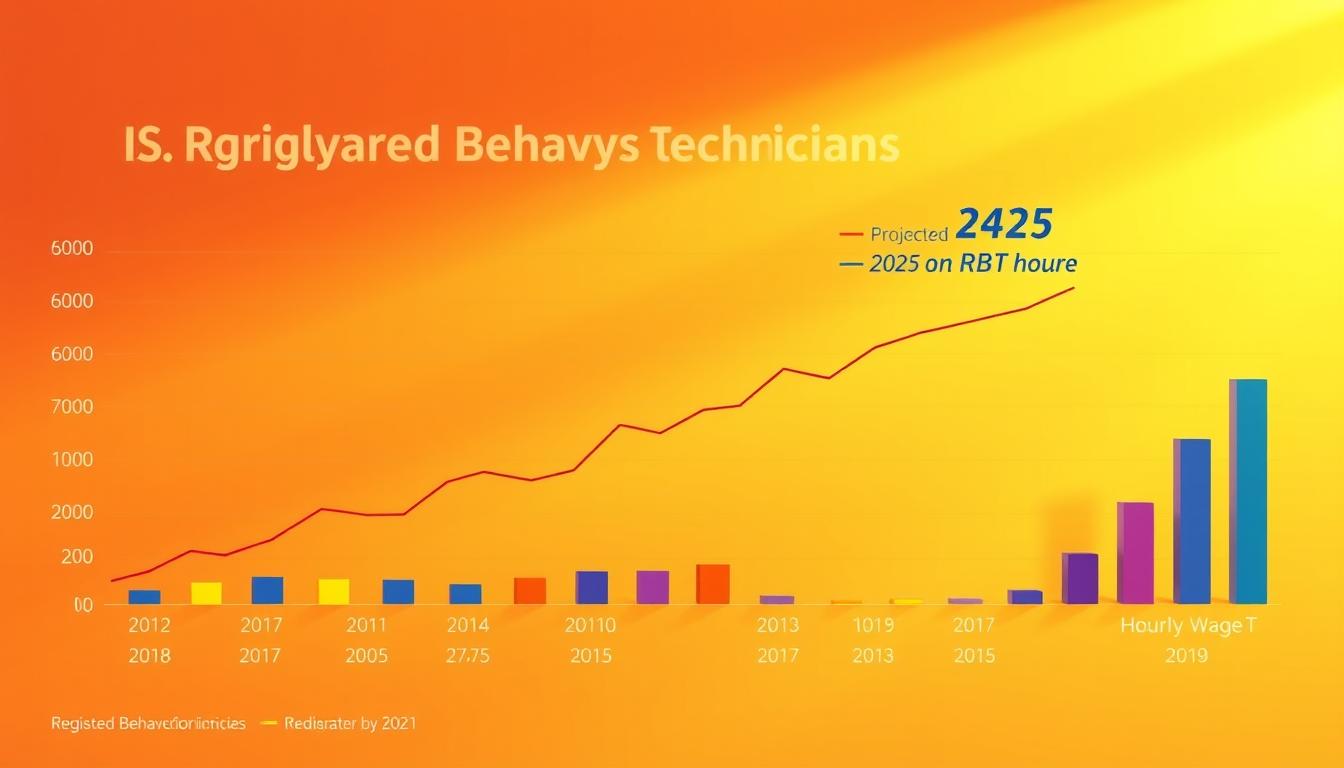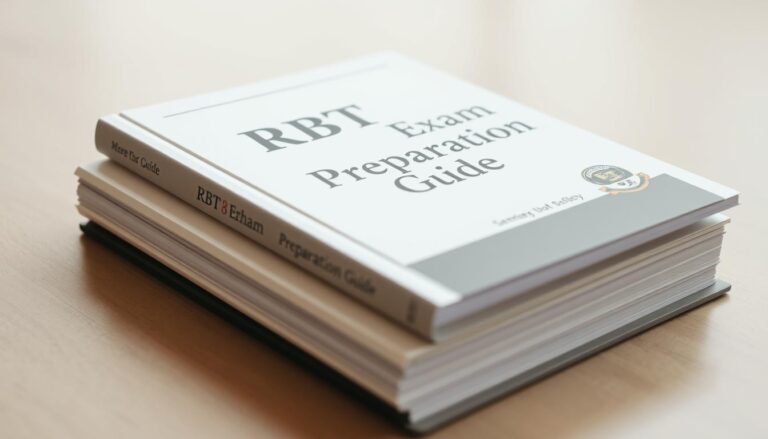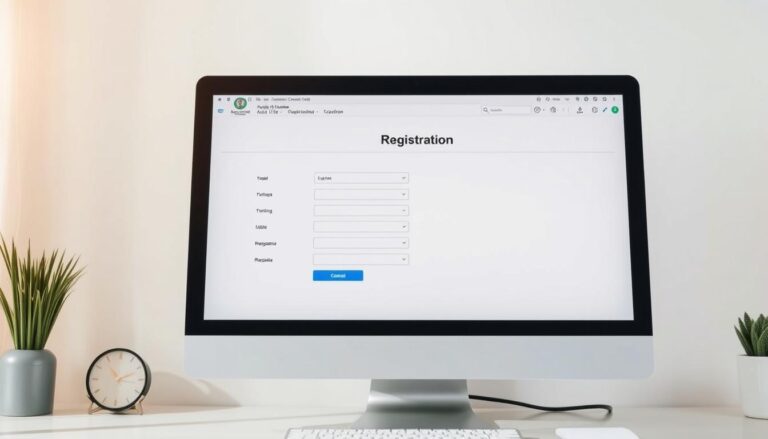RBT Pay Explained: What’s the Hourly Rate in 2025?
People working in applied behavior analysis are really interested in RBT pay. The hourly rate for RBTs is changing, showing more demand for these skilled workers in the U.S.
Knowing how much an RBT earns per hour is key for both new and experienced workers. By 2025, the pay for Registered Behavior Technicians will offer new chances and things to think about for health care workers.
RBT pay changes based on experience, where you work, and your skills. New RBTs can look forward to good pay that shows how important their work is. They help people with behavioral issues.
This guide will dive into the world of RBT pay. We’ll look at hourly rates, trends, and career chances. We’ll share the key info RBTs need to know about their pay in today’s health care world.
If you’re thinking about being an RBT or want to know about pay trends, this article is for you. It goes deep into the money side of this fulfilling job.
Understanding the Role of a Registered Behavior Technician
Registered Behavior Technicians (RBTs) are key in helping people with behavioral challenges, like autism. They offer direct care that affects their salary and hourly pay.
Key Responsibilities and Qualifications
RBTs work with Board Certified Behavior Analysts (BCBAs) to carry out plans. Their main tasks include:
- Collecting and recording behavioral data
- Implementing skill acquisition strategies
- Assisting clients in developing positive behavioral skills
- Supporting behavior reduction techniques
RBT Certification Requirements
To become an RBT, one must meet BACB standards. The process involves:
- Completing a 40-hour training program
- Passing a criminal background check
- Completing a competency assessment
- Passing the official RBT examination
Working Environment and Conditions
RBTs work in various places, affecting their salary. Common places include:
- Private homes
- Schools and educational centers
- Behavioral health clinics
- Community-based programs
The RBT role offers great chances for those eager to help others. It’s a fulfilling career path.
Current RBT Pay Trends and Market Analysis
The Registered Behavior Technician (RBT) job market is changing a lot in 2025. RBT pay rates are going up because more people need behavioral health services in the U.S. Knowing what’s happening in the market can help RBTs plan their careers.
Several key factors are influencing RBT hourly earnings:
- Increased autism spectrum disorder diagnoses
- Expanded healthcare coverage for behavioral interventions
- Growing recognition of applied behavior analysis
- Specialized training requirements
Recent studies show RBT pay rates are getting more competitive. Now, RBTs can earn between $18 to $25 per hour. This depends on where they work, how much experience they have, and their skills.
Where you work affects how much you earn. Cities and states that spend more on healthcare pay RBTs more. Places like California, New York, and Massachusetts pay more than rural areas.
There’s a trend where RBTs with extra certifications and skills earn more. Staying up-to-date with training and skills is key to earning more in this field.
How Much Does RBT Make an Hour: Complete Breakdown
Knowing how much an RBT makes an hour is key for those thinking about this career. Registered Behavior Technicians help people with behavioral issues. Their pay shows the value of their skills in healthcare.
Entry-Level RBT Hourly Rates
New RBTs see different hourly pay based on several factors. Entry-level jobs usually pay between $16 to $22 an hour. Those just starting or with new certifications often earn less.
- Minimum starting wage: $15-$16 per hour
- Average entry-level RBT hourly wage: $18-$22
- Factors influencing initial pay:
- Certification quality
- Educational background
- Local market demand
Experienced RBT Pay Scales
With more experience, RBTs earn more. Those with 3-5 years of experience can earn up to $30 an hour.
Geographic Variations in Pay
RBT pay varies a lot by location. Cities and states with higher living costs often pay more.
| Region | Average Hourly Rate |
|---|---|
| California | $24-$32 |
| New York | $22-$30 |
| Texas | $18-$25 |
| Midwest States | $16-$22 |
It’s important for RBTs to look into local pay and benefits. Special skills, extra certifications, and where you work can also affect your pay.
Factors Affecting RBT Hourly Wages
Understanding how much RBTs make involves looking at many factors. Their pay isn’t just a simple number. It changes based on their skills and experience.
Several important things affect how much RBTs get paid:
- Educational Background
- Professional Certifications
- Specialized Skills
- Work Environment
- Client Complexity
How long someone has been working also matters. New RBTs usually earn less. But, those with more experience can get paid more because of their skills and success.
| Wage Influencing Factor | Potential Impact on Hourly Rate |
|---|---|
| Advanced Certification | $2-$5 per hour increase |
| Specialized Behavioral Intervention Skills | $3-$7 per hour increment |
| Complex Case Management | $4-$8 per hour additional compensation |
Where you work also affects your pay. Cities and places with high living costs often pay more. Different places, like schools or clinics, might pay differently than hospitals.
Bonuses, extra pay for certain shifts, and overtime can increase what RBTs earn. Those who are very good at their job and reliable often get extra money.
Comparing RBT Salaries Across Different States
To understand RBT salaries, we must look at how they vary by location. The hourly rate for RBTs changes a lot depending on where you are. It’s important for RBTs to know the pay in their area.
Location greatly affects how much RBTs earn. Things like local demand, population, and healthcare services play a big role in pay.
Highest Paying States for RBTs
Some places pay RBTs more than others. The highest paying areas usually are:
- California
- New York
- Massachusetts
- New Jersey
- Washington
Cost of Living Adjustments
When looking at RBT salaries, we must think about the cost of living. A higher hourly rate doesn’t always mean you’ll have more money.
| State | Average Hourly Rate | Cost of Living Index |
|---|---|---|
| California | $22.50 | 151.7 |
| Texas | $18.75 | 91.5 |
| Florida | $17.25 | 97.9 |
Regional Demand Variations
The need for RBTs changes from state to state. Urban areas often have more jobs and better pay than rural places. States with big populations and strong autism support tend to pay more.
When choosing a place to work as an RBT, look beyond just the hourly rate. Think about the local job market and other factors too.
Benefits and Additional Compensation for RBTs
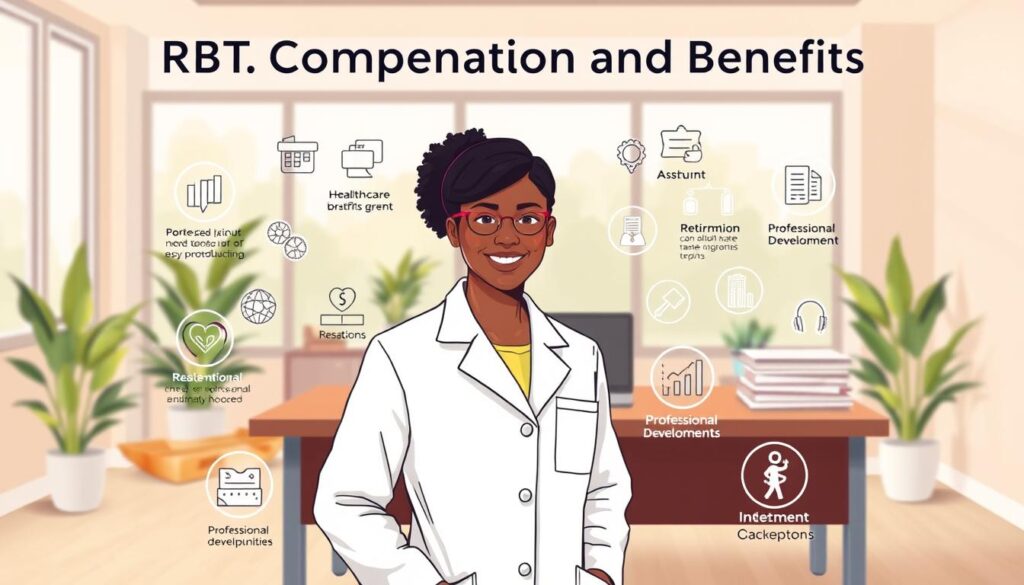
Registered Behavior Technicians (RBTs) get more than just their hourly pay. They also get financial and professional perks that make their job more valuable.
Benefits for RBTs go beyond just their hourly rate. They get a full package of rewards:
- Health insurance coverage
- Retirement savings plans
- Paid time off and sick leave
- Professional development opportunities
- Continuing education support
Many employers give extra money to help RBTs earn more. Sign-on bonuses can be from $500 to $2,000. This gives them a quick financial boost. They also get bonuses for doing great work, which can increase their pay.
There are also chances for RBTs to grow professionally. Programs help them pay for school and get certified. This helps them move up in their careers.
Some places offer special perks that make their pay packages stand out:
- Flexible scheduling
- Mentorship programs
- Career advancement pathways
- Mental health support resources
RBTs should look at the whole package of benefits. Money isn’t the only thing. Good benefits can make a job more rewarding and help with career growth.
Career Advancement and Salary Growth
Registered Behavior Technicians (RBTs) have great chances to grow their careers and earn more. The field of applied behavior analysis offers many ways to advance and develop professionally.
RBTs can boost their RBT pay rate by following several key strategies:
- Pursue advanced certifications
- Gain specialized training
- Develop leadership skills
- Explore higher-level professional roles
Advancement Opportunities
For RBTs, career growth often means moving into more specialized roles. The most common paths include:
- Board Certified Assistant Behavior Analyst (BCaBA)
- Board Certified Behavior Analyst (BCBA)
- Clinical supervisor
- Program director
Certification Impact on Earnings
Getting more certifications can greatly increase RBT earnings. Moving from an entry-level RBT to a BCBA can raise annual income by 50-100%. This depends on location and specialization.
Several factors affect salary growth:
- Years of professional experience
- Advanced educational credentials
- Specialized skill development
- Organizational leadership roles
RBTs who keep learning and growing can see big pay increases. Planning your career and striving for excellence are key to earning more in this field.
Industry Settings and Their Impact on RBT Pay

Registered Behavior Technicians (RBTs) earn different wages based on where they work. The RBT hourly wage can change a lot depending on the industry setting.
Each work environment has its own pay rules for RBTs. Knowing these differences helps RBTs make better career choices about their hourly earnings.
- Schools: Usually have stable but lower RBT hourly wages
- Private Clinics: Often give competitive pay packages
- Home-Based Services: Pay can vary based on client needs
- Residential Facilities: May offer extra benefits beyond hourly pay
Funding sources greatly affect RBT pay. Public schools, private insurance, and state Medicaid each have their own pay rules. Specialized treatment centers might pay more to attract top talent.
The size of the organization also matters for RBT pay. Big healthcare systems usually have steady pay scales. Smaller private practices might offer more flexible pay.
RBTs should think carefully about where they work. They should look at hourly pay, benefits, growth chances, and professional development opportunities.
Part-Time vs Full-Time RBT Compensation
Registered behavior technicians have to make big choices between part-time and full-time jobs. The pay for these jobs changes a lot based on the work schedule. It’s key to know the pay details.
Those thinking about RBT jobs need to think about the money side. The pay per hour can be very different between part-time and full-time jobs.
Hourly Rate Differences
There are big pay differences between part-time and full-time RBTs:
- Part-time RBTs usually make a bit less per hour
- Full-time jobs often mean more steady money
- Pay can range from $16 to $25 an hour, depending on the job
Benefits Comparison
| Benefit Category | Part-Time RBT | Full-Time RBT |
|---|---|---|
| Health Insurance | Limited/No Coverage | Comprehensive Plans |
| Retirement Plans | Rarely Offered | 401(k) Options |
| Paid Time Off | Minimal | Structured Vacation |
Part-time jobs offer flexibility, but full-time jobs come with better financial packages. Registered behavior technician salary plans show these big pay and benefits differences.
Negotiating Your RBT Salary: Tips and Strategies

As a Registered Behavior Technician, salary negotiations are key. Knowing the usual pay helps you set clear goals for your RBT wage per hour.
Start by doing thorough research. Find out what RBTs are paid in your area and based on your experience. Use this data to back up your salary request.
- Research local market rates for RBT positions
- Document your professional achievements
- Prepare a compelling case for your desired compensation
- Practice your negotiation dialogue
When talking about pay, focus on what makes you stand out. Talk about your special training, extra certifications, and skills. Quantifiable achievements can really help your case.
Think about more than just your hourly rate. Benefits like training, flexible hours, and health insurance add value. Be ready to discuss these during salary talks.
Good communication is key in negotiations. Be professional, confident, and open to talking. Show you’re committed to quality work and fair pay.
- Be professional and respectful
- Stay confident in your skills
- Remain open to constructive dialogue
If the first offer isn’t what you hoped for, ask for a chance to discuss it later. Some employers might raise pay after you’ve shown great performance.
Future Outlook for RBT Wages (2025 and Beyond)
The future for Registered Behavior Technicians (RBTs) looks bright. With more people needing behavioral health services, RBTs will find new opportunities. This is a great time to grow in your career.
The average RBT hourly rate will change a lot. This is because of several important factors:
- More people need autism and behavioral health services.
- Early intervention strategies are becoming more recognized.
- Healthcare technology is getting better.
- Certification for RBTs is getting stricter.
Industry Growth Projections
Experts say the behavioral health sector will grow a lot. The autism intervention market is expected to grow a lot. This will help RBTs get paid more.
Healthcare groups are seeing how important RBTs are. They play a big part in treatment plans.
Expected Salary Trends
By 2025, RBTs can expect a 10-15% pay increase. Several things will help this happen:
- Behavioral intervention techniques are getting more complex.
- There will be more training and specializations.
- More insurance will cover behavioral health services.
Those who keep learning and specialize will earn more. This field is always changing, and those who adapt will do well.
Private Practice vs Agency Employment: Pay Differences
Registered Behavior Technicians (RBTs) have a big choice to make. They can work in private practice or for an agency. The pay can be different, depending on where they work.
Private practice might pay more per hour. RBTs can set their own rates and control their earnings. This way, they can:
- Directly talk to clients
- Choose their own hours
- Make more money per hour
- Work more independently
Agency jobs, though, offer steady pay. The hourly rate might be a bit lower. But, agencies provide:
- Regular work
- Guaranteed pay
- Help with paperwork
- Benefits
Money matters go beyond just hourly pay. Private practice means spending on marketing, insurance, and running a business. Agencies cover these costs, giving RBTs a steady income at the start.
Experience is key in earning more. Experienced RBTs can earn more in private practice. But, new ones might find agency jobs safer financially.
Conclusion
Figuring out how much RBTs make an hour is complex. It depends on their experience, where they work, and their skills. RBTs can earn between $16 and $25 an hour. They can also increase their pay by getting more certifications and advancing in their careers.
The field of applied behavior analysis is growing fast. This means there are many chances for RBTs to grow. It’s important to look at the whole job package, not just the pay. Benefits, training, and chances to move up are key to being happy and successful in this field.
Knowing about the job market, local pay rates, and new rules helps RBTs make smart choices. With more autism and behavioral health services needed, RBTs have a bright future. Keeping up with training, networking, and certifications is essential for earning more.
This guide helps RBTs plan their careers with confidence. Working in applied behavior analysis is rewarding and well-paid. It’s a great choice for those who want to help others and earn well.
